Introduction
- Pediatric Occupational Therapist
- Founder of TimberNook, an international nature-based program
- Author of Balanced and Barefoot: How Unrestricted Outdoor Play Makes for Strong, Confident, and Capable Children
Today, we are going to talk about the therapeutic benefits of outdoor play. Here is a little bit about me. I am a pediatric occupational therapist, and I am the founder of TimberNook. It is an international nature-based program, and I am also the author of "Balanced & Barefoot: How Unrestricted Outdoor Play Makes for Strong, Confident, and Capable Children."
Outdoor Play Is An Important Occupation
Outdoor play is an important occupation. This is something that really directed me down the path of starting this kind of programming. I started as an occupational therapist in schools. I also worked in home health with preemies. Much of my experience was is an outpatient therapy clinic. I started with nature classes to get parents and children outside. I had a parent come up to me and say, "Why did the leaves change color?" I was not totally sure what the answer was, but it was humbling and an opportunity for me to really think about what was I doing. When I started this about 10 years ago, it was a nature program run more by naturalists or teachers, and I kept wondering what my place was.
True Occupation and True Play
- Play is recognized in occupational therapy as a central domain of childhood.
- Strong evidence of its importance for health, development and well being (Lester and Russell, 2010)
- Play is a choice.
- Freely chosen, intrinsically motivated, self-directed meaningful occupations
- About the process of engagement rather than the product (activities vs. experiences)
- Play occupation is the driver of learning in early childhood settings. However, children are not done playing yet when they reach primary school!
The occupation of a child is play and the central domain of childhood. There is strong evidence of its importance for the health, development, and well-being of children. I kept thinking of how we as OTs are good about bringing things indoors. OTs use swings, little bins of sand, etc. inside. I kept thinking, "What about outdoor play? Why are we not addressing this occupation?" The more I spent time watching children in outdoor play and compared that to what I saw inside, I realized how rich outdoor play was on so many levels and how it affects development and social-emotional learning. I feel like children even learn best through play. I felt that occupational therapy needed to look at this aspect of play.
The other thing that I thought about is that occupation is a choice all the way through the lifespan. For example, gardening is an occupation for some people. It is meaningful, and it is a choice. Other examples are knitting or reading. For children, play is a choice. Peter Gray talks about this a lot. He wrote the book "Free To Learn." True play only occurs when it is a choice. He also talks about how when it is an adult-directed activity and the adult is guiding the activity, this is not true play. It is more of an activity. He also even includes structured sports as these are more adult-directed. True play is when it is child-directed and a choice if they want to play or not. It is also intrinsically motivated and self-directed, meaningful occupations. I think this fits nicely with our profession.
Occupation is a choice and play is a choice. I really believe that we need to pay attention to using more true play opportunities for children as a therapeutic medium for them. We need to give children more opportunities for authentic play, not less. We will talk about why as we go on so you can start to really see it for yourself. It also is a driver of learning for early childhood settings.
I believe that children learn best through play because it is so meaningful, and those are the opportunities that they remember the most. I will give some more examples of that as we go on.
Common Play Behaviors Seen at Timbernook
- Building forts
- Climbing trees
- Society making
- Superhero play
- Rough and tumble
- Total immersion in mud
- Giant ball runs
- Sledding
- Making stores
- Keep away games & “stealing”
- Lots of “heavy work” of loose parts
- Playing house, animals, etc.
- Exploratory play
Here are some examples of play at TimberNook. So basically what we do is we work from ages 18 months all the way through about age 14.
We create outdoor play experiences for children. An example might be that after watching a puppet show about the three little pigs, they are given real bricks, hay, and sticks to build their own homes. This is when the adults step back and the children decide how they are going to build it and who they are going to build it with. They may choose to do something completely different as it is all a choice. We find that these play opportunities work really well with children with sensory and anxiety issues because there is a choice in the matter. An example for older children might be they have an opportunity to create a giant ball run in the woods. There will be all kinds of materials out there that they can build something by working together. We will talk about this a little bit later as well.
Recently, the design team for the Merrell shoe company came out. They also enjoyed this experience. They were given different parts like giant tubes, gutters, duct tape, and different pulley systems to create their own ball run. It was super meaningful and fun for them. They got competitive and were really challenging themselves.
You often see leaders come forward and a lot of regulating emotions. For example, someone might get upset with someone else. They get to practice all those skills that are hard to replicate in a more traditional setting. In school classrooms, kids are usually the same age or in a clinical setting, there are usually only one or two children at a time. Thus, with these play settings, it is really neat to have multiple children of different ages out there learning together. There are all sorts of different play experiences. I think we have at least over 300 different play experiences, and we keep creating new ones all the time.
Authentic Outdoor Play Is Sensory-Rich
The first thing I want to talk about is how authentic outdoor play is a sensory-rich for children. This is hard to replicate in a more traditional clinic setting. Hopefully, by the end of this, you will all become advocates for outdoor play in a bigger way. One thing I want to talk about before we dive in is that there is another presentation on OccupationalTherapy.com called "The Decline Of Outdoor Play." I highly recommend listening to that one as well because it dives into what has happened to children over the past 30 years. We have restricted their movement opportunities by restricting play outside. We have seen changes in development. I recommend listening to that presentation because it will make the connections for you and dive a lot deeper than I am going to with this presentation.
Outdoor Play Is Becoming Rare
- Children today spend far less time outdoors than prior generations did
- This is affecting children’s healthy sensory development
- Decreased attention
- Posture is changing
- Increased falling
- Rise in anxiety
- Play is changing
One of the main issues is that we are seeing is decreased attention in children. For instance, one teacher said in the early 1980s, she was able to teach a whole classroom, and she said maybe one or two kids had trouble paying attention back then. But now, she said on a good day at least eight of those 26 kids are struggling.
Posture is changing as well. This is another thing that physical therapists and chiropractors are seeing. They are seeing pre-adolescent posturing at an earlier age where there is this rounded curvature. They are also treating back pain at an earlier age. One reason for this is that children's core strength is weak. Their stomach and back muscles are not quite as strong as they should be. Another issue is that they are looking at screens a lot with their head in a forward position. Another important reason is that they are sitting for hours during the daytime. When you are constantly in a seated position, this is going to affect gait and posture as well. Certain muscles will shorten while other muscles will lengthen.
Increased falling is another thing that we hear over and over from teachers. Kids are falling out of their chairs to the ground. Teachers are reporting more clumsiness and that kids are running into each other.
There has also been a rise in anxiety and depression in the past 10-20 years. I am really interested to see what is now happening with the pandemic.
Play is changing. Recess monitors say that 30 years ago they saw a much more imaginary type of play. Now, they are seeing a lot more structured games.
Outdoor Play During and After the Pandemic
We have been given a unique opportunity during this time. Everything has stopped and slowed way down. And, in some places in the world, it has become harder for children to access outdoor play. However, in other areas, we are starting to see more and more families go outside and find that nature is their respite during this time. What I am learning is that outdoor play with other children is going to be needed more than ever due to more isolation. Mental health is going to be a priority when this is over and they are going to need to play with other children. They are also going to need a safer way forward, and some schools are starting to look at how outdoor learning opportunities are going to be a creative and safe way to reopen schools. This is something that we have been advocating for as well.
Nature is the Ultimate Sensory Experience
- Engages all the senses
- Man-made versus natural
- Calm, but alert state of mind
Nature is really the ultimate sensory experience. Multiple senses that are engaged. You feel the wind on your face, the sun beating down on you, and it might be raining or snowing. There are multiple senses are engaged. When you walk indoors, it is always flat. In contrast, the ground outside is uneven and you constantly need to adjust your muscles and senses. There are multiple chances for organization and sensory integration.
Another thing to keep in mind is that the ideal state for sensory integration to happen is to be in a calm but alert state. The colors outside are blues, greens, and browns. These are very calming colors. There is research around that and preschools and prisons are painted those colors. Think about going for a massage. They play music like crashing waves, bird sounds, and nature sounds. There is also a reason why doctors say to bring your babies outside to calm them. Additionally, there is research that says that certain trees reduce the cortisone levels in the brain. Thus, outside provides calming stimuli. However, you are still alert when you are outside as there is so much to pay attention to. The ground is uneven, you may see an animal run by, and you are constantly assessing your environment. You are in an alert state which is ideal for sensory integration.
We need to think about what percentage of time our children are in an environment that is conducive to the integration of the senses? And, what percentage of the time are they in an environment that is not conducive to that type of organization? It might even be dysregulated or unorganized. I often think of environments where there are a lot of posters on the wall, lots of noise, and a lot of children together in the close quarters. All of this can affect that.
In the past, children spent four to six hours on average of outdoor play. When I got home, I went outside until the lights went off. I spent hours digging in the dirt and playing with friends outside. Now, children often get about 45 minutes to an hour if they are lucky. That is not a lot of time outside in that ideal environment. The research shows approximately 48 minutes of outdoor play.
The Vestibular System
- Uses hair cells in the inner ear complex
- Helps children know where their body is in space
- Supports all six eye muscles for reading and writing
- Maintains the Reticular Activating System, which turns the brain on and allows us to pay attention
- Feeds into the limbic system, the center for emotional regulation
Outdoor play is ideal for the vestibular system.
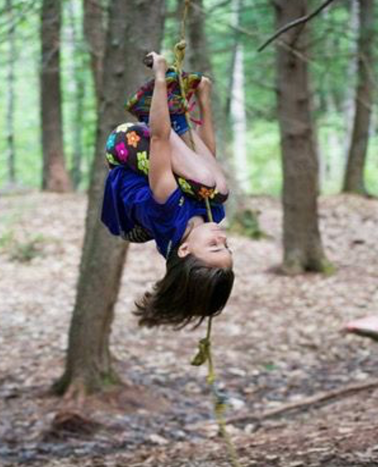
Figure 1. Swing at Timbernook.
One thing to think about is that children are constantly in an upright position when sitting in their seats for upwards of nine hours a day. This is astounding. That is a lot of time sitting. If you think about that, many kids are being driven to school, are in a seated position all day, and then are driven home. They then have homework which can take hours and they are seated upright. This is pre-pandemic. Children need to move frequently throughout the day. They need to go upside down, spin in circles, and move their head back and forth in vigorous ways to move the fluid in the inner ear to stimulate hair cells to develop the vestibular system. This sense is really key for sensory integration. It helps to tell them where their body is in space, walk from point A to point B safely, and get on and off playground equipment efficiently. It really helps them to become safer. When I observe at places, often I hear an adult say, "Don't spin because you're going to get dizzy and fall. Or, "Get down from that rock because you're going to get hurt." If we constantly say no, then we become a barrier to their neurological development.
The vestibular system also supports six eye muscles which are really important for reading and writing. We know that occupational therapists work very closely with behavioral optometrists because vision is not addressed by just reading an eye chart. If you go to their office, you will see trampolines and swings like us. They support the idea that movement helps with visual skills for reading and writing.
Another thing that the vestibular system does is it turns the brain on to pay attention. It turns on the reticular activating system. This is why kids fidget. They are moving back and forth because they are trying to ignite their vestibular system to turn the brain on. However, teachers often say, "Sit still." Clearly, kids need to move not just at that moment but really throughout the day so that they can have that strong vestibular system to support development.
It also feeds into the limbic system which is really important for emotional regulation but also activity regulation to bring that back down again. We want kids to go upside down on swings, climbing trees, rolling down the hills, and jumping off rocks. We want them to constantly challenge their vestibular system and to move frequently throughout the day. This supports their development, attention, activity regulation, and all of that. Additionally, it can support learning in the classroom.
Common Ways Children Stimulate the Vestibular Sense
- Rolling up and down hills
- Sledding
- Mud slides
- Tree climbing
- Spinning in circles
- Swings
Here are some ways to do that through outdoor play. Sledding is a really great one, especially in different positions. I love seeing kids fully immersed in the mud. Tree climbing is a really great one because the child is looking up, looking down, and looking where their next hand placement is going to be. Other examples are spinning in circles and swinging outside. We use a rope swing at TimberNook as you saw in Figure 3. We love it as they can use it in many different ways. They can go upside down, sit on it, or climb it. Tere is a lot more choice with that.
The Proprioceptive Sense
- Considered “heavy work”
- Push and pull resistive activities
- Examples: Shoveling, building a dam, digging in the dirt, carrying heavy buckets of water
The proprioceptive sense is also something that can really be activated fully outdoors. Many kids are on electronics pushing buttons, but they are not getting that deep pressure or heavy work. They are not getting resistance to their joints and muscles that help develop their sense of where their limbs are in relation to each other. They also need this sense to know how much force to use when playing games like tag, holding a baby chick without squeezing too hard, or writing without breaking the lead. Or perhaps, they are not writing hard enough. In fact, we are starting to see a lot of issues with tag where kids are using too much force. Schools are starting to ban tag because of this. We need to advocate for more opportunities for heavy work. I really feel like this is best done outdoors where children have plenty of space to move around. Examples are shoveling, building dams. or picking up heavy rocks. This is all done through meaningful play. It is both important to them and motivating. Other examples include digging in the dirt for hours and carrying heavy buckets of water. It is even more meaningful that they are getting proprioceptive sense stimulation through that.
Playing With Loose Parts
- Loose items for building
- Adults step back
- Use the environment as inspiration
I also think that using loose parts is a really great way to inspire proprioceptive work. Again, you do not have to force it on the kid but instead inspire through the use of the environment. This leads to child-directed play. It is so motivating for kids to play and use materials in ways they have never done before. We will often place large items for building outside on purpose because the first thing kids do is build forts. They want to build a space especially if they are here for a longer time. We have programs that run year-round, and we also have programs that run for a week at a time. In our summer camps, the older children want to create their homes the first day. What better way to get that heavy work? We supply pallets, planks, and tires.
Loose Parts
Using materials called loose parts is great for proprioceptive work, but it is also great for many other reasons. These help to promote creativity. For instance, if a child does not have a lot of practice, they will come back and say, "There's nothing to do out there but sticks, rocks, and leaves, and I don't have any ideas." This is because they do not have what we call visual affordances. They have not seen those loose parts used in different ways yet. If you send that same child back out, and he gets bored, he might pick up a stick and start digging with it. Now, he has one idea. "I can use this as a tool." He also has one affordance. Let's say then he starts writing with it in the dirt. Now he has two affordances. "I can use this as a writing utensil, and I can use this as a tool." Let's add other children to the picture. They may see another child using a stick to build a fort with it and realize, "Oh, I have three ideas on how to use a stick. I can use that as a digging tool, a writing tool, and I can use it to build forts." They are seeing children using materials in different ways. And the more practice they get with those materials, the more visual affordances they get and the more creative they get over time. Each year at TimberNook, we say this is the most creative we have ever seen because the same kids come back. They want to keep having these play experiences but they always outdo themselves and bring their play to a whole different level. They scaffold on their previous play opportunities. They get new ideas and then other children come and inspire those children to play in ways they have never played before.
Examples of Loose Parts
- Stones
- Tree cookies
- Bricks
- Fabric
- Logs
- Wood planks
- Gutters
- Pallets
- Baskets
- Egg crates
- Tires
- Dishware
- Tarps
- Buckets
Here are some examples of loose parts that we commonly use at TimberNook. The key is using the environment as inspiration so the adults can step back and allow the children to direct their own play. This is how we get to more child-directed play experience and true occupation for children. We empower and inspire. Here is an example in Figure 2.
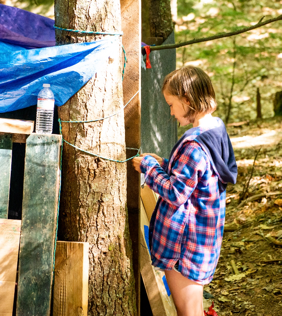
Figure 2. Child directing her own play with loose parts.
One example is sheer curtains. The kids like them as they are transparent. Kids will use them to dress-up or build forts. In the forts, it can be a way to see others coming. They are used for multiple purposes, and this is why we like using those versus putting specific dress-up clothes outside as they are limited in their potential. We use heavy bricks so that they get that proprioceptive feedback. They also feel the texture from the bricks. Children want to play with real materials, and it is very inspiring to have permission to do so. Gutters and pallets of baskets are other examples. They will grab the baskets and use them for their own ideas.
As adults, we want to be the idea givers and children over the years have relied on adults to direct their play. They will turn to adults as if to say, "Is this okay?" They constantly seek reassurance. If we are very close to where they are playing out in the woods, they will turn to us to solve their problems for them. However, what we have learned over the years is that if we step back and we reduce adult presence out there, the children will turn to each other and start solving their own problems. It is a beautiful thing to watch. It is something that they are not given enough opportunity to do but it is such an important life skill for them.
The Tactile Sense
- Full body engagement
- Multiple senses engaged
- A variety of tactile experiences
- Examples: Going barefoot on a log, playing in mud puddles, climbing a tree, gardening, etc.
When a child goes outside, they get the full-body engagement of their senses. This is true for the tactile sense as well. Look at this little boy in Figure 3. He is totally immersed in a giant mud puddle.
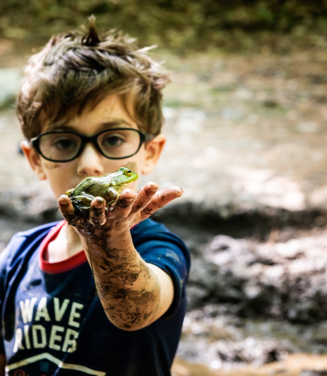
Figure 3. Boy with a frog.
To capture the frog, he had to get into the mud, and now the slimy frog in his hand. This is full-body engagement, and he is totally immersed in that sensory experience. Other examples are going barefoot on a log and climbing trees. The whole body is engaged. Sometimes we have sensory balance beams or other simulated tactile experiences like in Figure 4. Now let's compare what happens when we take the sensory experience outdoors.
Example of Indoor Vs. Outdoor
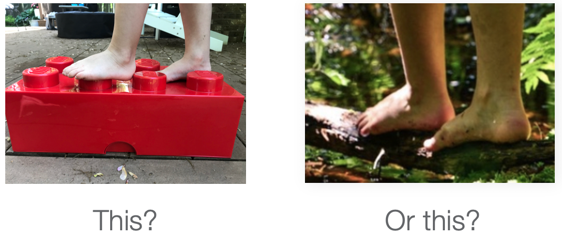
Figure 4. Plastic balance beam vs. a log.
Which do you think provides a richer sensory experience that is going to create change in the child? If you look at the images and dissect them, you will understand it on a deeper level. For one, the plastic balance beams often are the same throughout. The tactile sense might vary a little bit, but for the most part there, there is no give to it. With the one on the right, when they walk on the log, the log will usually move with them. And so right away, you are going to challenge their dynamic balance. You are starting to increase the challenge right away. If you look at the feet on the right, you can see that they are grasping onto the log, holding on, and working harder. The muscles and the feet and the ankles are being challenged more. You are getting to multiple senses. Additionally, with the right picture, you are going to get muddy and there is an element of risk making it meaningful to the child. The log is off the ground, and there is water underneath. They can also choose to stay on the log or get off if they want, and there is probably room for other children. They may also be using this log in an imaginary type play scenario. So, there are multiple things happening in the right picture.
The other thing is sometimes when we set up obstacle courses for children, like in the left picture, this is preconceived and adult-directed. Often when children have sensory issues, there is usually anxiety tied with that. At Timbernook, they have a choice if they want to get on the log. The child might get on that log, they might get off, or they might decide to jump on it a different way. As it is a choice, it starts taking away that pressure.
I have a great example of a little boy that came to TimberNook. He knew we were going to go to our giant mud puddles, and he had on plastic welly boots. I remember him saying, "I will go to those mud puddles but I'm not taking my boots off." And so I said, "Okay, that's fine." He was observing other boys catching frogs, and he got so excited that he ended up going right in without thinking about it. The mud went in his plastic welly boot. He came back out and he said, "Can I take these off?" He took him off and went back in barefoot. That play trumped his fear, anxiety, and sensory issues. When we told the mother and she said, "Do you know that he had been working on trying to go barefoot two years in a clinic setting. It has been unsuccessful." However, because this experience was so meaningful and exciting for him, he went right in without thinking. The other nice thing is that it was a real environment. It was easy to generalize going barefoot in that mud puddle to being barefoot when he went camping. Then, he started going barefoot whenever he was outside. Just because a child is going barefoot on this giant Lego does not mean they are going to be tolerant going barefoot in the grass or in the dirt.
Here's another example of how the natural world can take sensory integration to a whole new level. There is nothing wrong with sensory bins, but I want you to think about the richness of outdoor play and what it can offer sensory integration. You cannot replicate that indoors.

Figure 5. Sensory bins vs. a beach.
Looking at both of these sensory experiences which of these is going to create a richer sensory experience that is going to create change in the child. Which one do you think will better meet that need? When you have a sensory bin, there is only a certain amount of space. You might be able to fit your hands in or your feet in. As you see these two children are crammed together trying to get into the sensory bin. On the beach, you can have multiple children having more engagement as there is plenty of space. Another thing is that you can start really integrating that tactile sense. The sand can be felt on most parts of the body on a beach. However, some kids may not like this. We hear about how a brushing protocol and/or deep pressure helps to integrate that light touch sense. With these little sensory bins, you are not going to get that deep pressure. In contrast, on the beach, children are constantly being stimulated by the sand and integrating that light touch sense. So again, outdoor play is more conducive to sensory integration that is hard to replicate in an indoor setting.
Social-Emotional Learning
Social-emotional Skills Through Authentic Play
- What is the best way for children to learn social skills?
- Through play with other children!
Let's talk a little bit about social-emotional learning. Another thing to think about is that children really learn best through play and especially for social skills and regulating emotions. I have many examples of this, but one that comes to mind is this. These girls built a fort, and they were so excited about it. They had little gems that they were hiding in there, and they were decorating and singing. All of a sudden, this boy went up to them and said, "You need to let me play." Right away as adults, we want to step in so that everyone is happy. However, something told me to just wait and see what happened. This was very early on in our TimberNook journey. I was still learning about when to step in when not to. He had scissors with him so that put everyone on edge. We were watching him for safety, but we were not intervening as they were just arguing. The girls formed a chain and held hands and said, "No, no, no, you won't." He cut their twine at the entryway, put the scissors down, grabbed the fake gems, and took off running in the woods. They ended up chasing him around the woods over and over again. One of the people, that was training with us, said, "He's bound to get tired." He did, and he said, "Fine, just take them," and gave them back the gems. He was upset and was sulking with his arms crossed. The girls saw this, went over to him, and one little girl even sat down beside him. That was unexpected. The girl started talking to the little boy, and he got really upset. We could not hear what they were saying. We could tell he was upset and yelling. She would put her hand up and patiently wait until he regulated and brought his voice back down. This happened several times, and then they had a conversation. Once he was calm, this little girl invited the boy to play with them, and that little boy was authentically included for the rest of the week in their play. If we had gone in right away and said, "You need to let him play," what opportunities would they have missed out on learning through that experience? The girls learned to stand up for themselves and said no. The boy learned about regulation, and he was listened to. The little girl that sat down beside him got on his level, and she practiced some advanced skills. Lastly, he was authentically included. This was another big key to how they solved their own problems. If we had done it for them, they could have been resentful towards each other, and they could have had ongoing issues throughout the week that needed adult interaction. But because they chose the rules and they decided what was fair to them, there were no longer any issues. We need to allow children to practice those more advanced problem-solving and social-emotional regulation skills. Again, these are really best learned through play. When I was growing up, I would often go and trade things. I would negotiate, and it was not always fair. During this, I learned many different skills.
Peter Gray wrote the book, "Free To Learn." I recommend reading his book if you are interested in authentic play. He talks about allowing children to have regulation and learn those skills through play and not always having an adult do it for them. When we direct all their play, children become reliant on the adult to do everything for them.
Child-directed Play With Others
- Children establish their own rules (snow fight)
- Practice taking on different roles, try new ideas
- When adults step back, they solve their own problems
- Practice emotional regulation
- Loose parts support engagement
- Develop empathy
Here are some other examples of child-directed play opportunities and why they are so good. When the adults step back, children solve their own problems. Remember, I told you that if we stood too close to where kids are playing, they often looked in our direction. For instance, if we were standing where the girls were building the fort, they would have turned to us right away without solving their own problem. They practice taking on different roles and whatever it is that is going on in the world through play.
Let me give you an example of role-taking. One time we were in the woods, and I heard a horn blowing. A child had built a horn out in nature, and all of a sudden all these children came running throughout the woods. They lined up, and the child with the horn had a feathered mask on and said, "You are top spy your top commander, you are..." and started creating a hierarchy of roles. The children were all raising their hands and saying, "I think so and so should be the person to do this." These were some advanced social skills, and it was really fascinating to watch. On the other side, there was another group of children, and they were holding a council. They were going to go to war but in the sense of "Capture the Flag" type play, Often, children do not have the opportunities to dive that deep into play. We give them shorter stints of play like recess for 20 minutes. They spend that time figuring out who they are going to play with and what they are going to play the entire 20 minutes. Then, when they are about to jump into that play scenario, the bell rings. It is not a wonder why we have to have more social skill groups to address more advanced social skills. We have to give them more opportunities to practice that through deep play. I want to give two short case scenarios about true authentic play as we wrap up.
Case Study #1
This is a little child with cerebral palsy and had crutches. We have always had children with all different abilities come to our programming because we believe in a full-inclusion model. Children with special needs thrive in a program where it is true neighborhood play. I used to get asked a lot if I did camps for kids with special needs. We tried it one time, and it really was not really TimberNook or the same experience. Instead, we find a way to have children with special needs to join the group. We feel like those are our biggest transformation stories. The research says they learn better from their peers than they do from just an adult model. We had gone to a local agency because we were really curious about how to be more inclusive of children with more physical challenges. We have always had children on the autism spectrum or with different sensory issues, but we were really curious about how to make this outdoor play more accessible to children of physical challenges as well. We found a location that creates adaptive equipment that allows children to access opportunities like hiking, skiing, and that sort of thing. We asked about outdoor play. She said, "Absolutely, we're willing to work with you." The rental equipment that they use is very inexpensive, and they rent it for a day. She recommended this particular child as our first case study because he did not need a wheelchair, but he had some physical challenges. She thought that he would love this opportunity.
We worked with them and what we saw was fascinating. He kept right up with other children. There was a point at the beginning of the week that some of the kids felt bad for him. He wanted to steal something from the girls' squad which is a game they play sometimes, and my daughter who was 10 or 11 at the time said, "Just take it." She was trying to help him but what they learned over time is that he just wanted to play. One of the times he went to steal from the girls after he worked so hard to get there, he took something and as he was walking away, he screamed. Our nurse on hand was like, "Is he hurt?" However, he had this huge grin on his face because one of the girls stole the thing back, and he was thrilled by that.
At another point, he was pulling himself up on some giant boulders. The boy clan that he was hanging out with came up to him and said, "Dude, are you okay?" He said, "Yeah, I just stole from the girls, and they don't even know about it." He was not even talking about his challenge to pull up on the boulder, but rather he was talking about his victory. He felt totally included. We got a great video of this interaction.
He did have physical therapy after TimberNook, but due to the amount of work he was doing during this experience, he did not go again during this time period. In fact, the PT said, "You cannot replicate this in therapy!” He was walking through giant mud puddles, pulling up on boulders, and climbing trees. He was just fully immersed in it as seen in Figure 6.
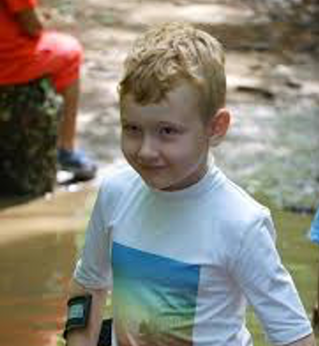
Figure 6. Case study 1.
He told his mother at the end of the week, "You said this was a week. This is only for 5 days." He had never played like this. At school recess, he always sat on a little blanket and would play card games. He was not fully immersed with other children. But at TimberNook, he was just fully immersed in the play experience. He had an incredible time. We need to start breaking down barriers and think about creative ways to allow children of all abilities to access outdoor play in a bigger way.
Case Study #2
Here is another case study. This past year we have seen about four different children from different sites in America with selective mutism. We have also had some incredible success stories with children with anxiety. This is my son Noah who is four.
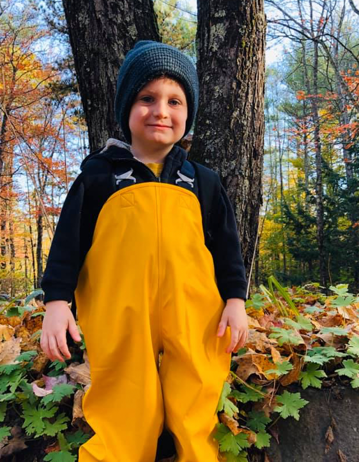
Figure 7. Case study #2- My son Noah.
I have two older girls that are young teens and then I have this little guy. He has selective mutism we think. At this point, we did not have an official diagnosis. When he is in a social situation, he does not talk at all. He started in a regular preschool, but he would not talk to the kids or the teachers. When he started TimberNook, he was pulled into advanced play schemes. The other children had him in cooperative play. For example, girls had him helping to build a bridge. What was really nice about this is that it was his choice. Children with selective mutism often have anxiety, and their ability to make choices really lessens the anxiety for them and breaks down the barriers. And as the play was so meaningful, this would often draw him in as he wanted to be a part of the experience. The other really nice thing is we have mixed ages out there because it is true neighborhood play. It was from ages four to seven. A couple of the six and seven-year-old girls just loved him to death and so they would pull him into the play. It brought him from a parallel level of play to more cooperative play right away.
Remembering Our Roots
- What are our true objectives?
- Is it meaningful
- Child-directed
- Creates change in the child
- Generalizes easier in “real” environments
Think about the true objective"s when you provide play opportunities that are therapeutic for children. One of the key questions I always ask myself when I am developing a curriculum or opportunities for kids, in general, is, "Is it meaningful?" Another is, "Is it something that as a child you would have enjoyed?" One thing that really helps us is we look at it through the perspective of giving a play experience. For example, look at Figure 8.
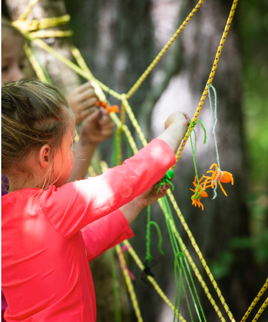
Figure 8. Girls making a spider web.
The children are creating a giant spider web and decided to tie spiders on to the web. When you set up a true play experience, you are going to see all the things you want to see and more within that experience. They were working on fine motor skills by tying and cutting with scissors. There is also that social-emotional piece. The girl in the picture is balancing on uneven terrain and is having to reach into the basket to grab the spiders. In that kind of environment, it is working on multiple goals at one time. And if it is child-directed, it is going to be a deeper, richer experience for them. There is going to be a lot of learning involved and creating that true change in the child that will generalize over into real environments. We want to empower these kids to play again. Many kids are losing the ability to play, and I think that is a big disservice for our children.
Occupational Justice
- A decrease in outdoor play
- Health & well being depends on it
- Restore & enrich the outdoor play experiences of children
I do feel like this is a form of occupational justice. We are trying to do make a difference as we have seen a drastic decrease in the amount of outdoor play that kids are getting. It is affecting their health and development in ways we never expected. It is our duty to not only restore their outdoor play opportunities but to really enrich those. There are some very easy ways to do that.
Providing More Opportunities for Outdoor Play
- Advocating for longer recess sessions for increased engagement, regulation, social skills
- Promote more outdoor play experiences both at home and at school.
- Taking therapy outdoors!
We need to advocate for longer recess sessions. Those 20-minute recess sessions are not enough to get into the more deep play opportunities that we want to see for all the reasons we have talked about. We want to promote more outdoor play experiences both at home and at school. There are some pretty simple ways to do that. Again, it is using that environment. Set up loose parts like baskets and adult materials that children do not typically get to use. These are very inspiring to them. For instance, you can go to Goodwill, garage sale, or find junk in your basement. You can put old platters, pots, and pans near a mud puddle. This can inspire hours of play in a toddler. In the wintertime, think what else can you put out in the snow besides sleds. Can you put out a rope, boxes, and duct tape? Can they create their own sleds? Get creative on how you stage your environment as it will inspire different kinds of play both at recess time and in the home environment. It does not need to cost a lot as you can often use materials that you already have at home. Lastly, take therapy outdoors. You can do this on a small scale and rethink some of your techniques. Using true occupation is so therapeutic.
Summary
If you want to find out more about us, you can find us at timbernook.com. We work with schools, and they can also be certified to use TimberNook programming year-round. We also certify professionals that want to bring this opportunity to their communities. "Balanced And Barefoot" dives deeper into all the underlying issues that are going on but also the way forward for children and how we can help them through true play. Lastly, you can find me and TimberNook on Facebook.
Questions and Answers
Do you ever have any problems with bullying?
We actually find less of that. It is funny because there is research on this. Look up the Swanson Elementary School. A university in New Zealand worked with three elementary schools and went from a half an hour recession to a full hour. They also got rid of many of the rules and found a decrease in bullying and an increase in attention. If there is more choice, more space, and more time, it is a more calming environment. The other thing is that it is a privilege to play and their rights can be taken away.
You discuss making these play experiences and opportunities optional to the children. Can you explain how you do this and how you would set it up? Do you make different stations or that they can explore independently?
We call it staging. We create almost like a giant invitation to play. We have special training that we do. When we train providers, they come for a full week and get immersed in the philosophy of TimberNook. The other thing we do is reduce transitions because we feel like there are too many transitions in children's lives. This is part of the problem. It is all staged to inspire play, and it happens naturally. And often, the other children are part of the inspiration. They will see kids play in new ways and that inspires them as well. The book does talk about this on a small scale for home environments and school environments.
How can we encourage parents who tend to be helicopter-types?
The book will talk about that a lot more. I also talked about this in my other talk on OccupationalTherapy.com, The Decline Of Outdoor Play. We are at the point where we are seeing changes in physical and sensory development because we have overly restricted children.
Do you see differences when children play in a forested area versus an open field or at a park?
I feel like the forest has many more benefits. We talked about trees reducing cortisone levels, but playing in the trees is very grounding. This is just based on observation but we have even noticed that kids change their noise level. When we are meeting up, we have two different areas. There is the drop-off area, the noise of the children is higher. When we go out in the woods and it is time to play, there is a hush that comes over the woods. There is also so much you can do in trees as well.
References
Available in the handout.
Citation
Hanscom, A. (2020). The therapeutic benefits of outdoor play. OccupationalTherapy.com, Article 5303. Retrieved from http://OccupationalTherapy.com
